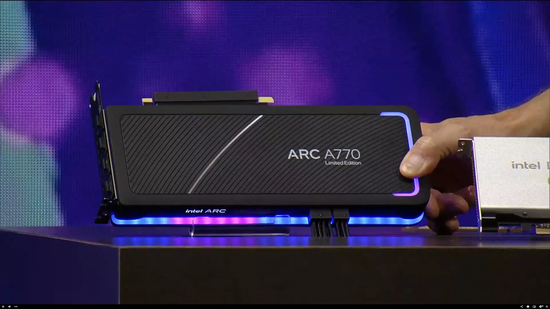your current location is:Home > TechnologyHomeTechnology
Intel launches new gaming graphics card to challenge Nvidia with cost-effectiveness
Intel announced at its technology summit that it will start selling new gaming graphics cards for gamers next month. The move is expected to break Nvidia and AMD's monopoly on the gaming graphics processing unit (GPU) market.
Intel's upcoming new gaming graphics card A770 is priced at $329 and is expected to be available on October 12. The price is comparable to Nvidia's RTX3060, but the graphics card's gaming performance is more advanced than the RTX3060.
It is worth noting that Nvidia just released the high-priced RTX40 series of gaming graphics cards last week. This time, Intel’s price of $329 is in the mainstream shipping price range of gaming graphics cards. It focuses on cost-effectiveness and is expected to win a certain market.
Intel said that it is committed to providing gamers with a choice of price and performance balance through the Ruixuan graphics card family. "For a long time, GPUs were $200 to $300, and since then they've become very expensive," Intel CEO Pat Kissinger said. "People pay high prices for the fastest, most advanced graphics cards. Tired, we don't think it's necessary and we're working on it."
The A770 is positioned at the mid-range, with 16GB of GDDR6 memory, 2100MHz frequency and 32 Xe cores. Intel hasn't released full test scores for the A770, but says it outperforms the Nvidia RTX3060 in ray-traced games at 1080p resolution. Intel emphasizes that the new graphics cards will provide 65 percent better ray tracing performance compared to the competition.

In terms of software technology, Intel claims that Ruixuan graphics cards support XeSS super sampling technology, similar to NVIDIA's DLSS technology, which can accelerate game performance on Intel discrete graphics cards and integrated graphics cards. Many existing games will gradually release update patches to enable support, and it is expected that more than 20 games will support XeSS technology within this year.
After Intel announced its return to the discrete graphics card market, there was a lot of action during the year. Earlier this year, Intel launched its first graphics card product, the A380, for the mid-to-low-end consumer market, but its market impact was limited because it had problems in software driver adaptation and channels, making it difficult to quickly open the market. In August, Intel launched the Flex series of GPUs for the data center market, which supports cloud rendering and AI applications.
It should be noted that the A380, as Intel's first consumer-grade graphics card product, is still only available in the Chinese market. That is to say, for overseas market players, the A770 will be the first Intel gaming graphics card product that they can buy.
Previously, in the GPU field, Intel stuck to the integrated graphics market bound to its own central processing unit (CPU), and ceded discrete graphics to Nvidia and AMD. The performance of the integrated graphics card is significantly different from that of the discrete graphics card, and it is difficult to support complex applications such as video games and professional design. The core of the discrete graphics card is a high-performance graphics processor. In recent years, with the excellent application of high-performance GPUs in AI training, the performance and market value of NVIDIA and AMD have risen together.
In addition to graphics cards, Intel also officially released the 13th-generation Core processor family, which uses the Intel 7 manufacturing process and the third-generation enhanced SuperFin transistor technology. The flagship i9-13900K is known as the fastest desktop processor, capable of reaching 24 % Game performance and 34% creative performance improvement.
A strong software development ecosystem is increasingly becoming a competitive advantage for semiconductor hardware manufacturers, which is one reason many developers use Nvidia chips for AI development because of its large user base for its CUDA software platform. Therefore, Intel also announced plans to expand the scale of the "Intel Developer Cloud Platform" on the same day, which allows customers to test a series of new chips, including Intel's latest data center CPUs, GPUs, Habana AI chips, etc. Attract more software developers to use its chip products.
Nick McKeown, director of Intel's networking and edge computing division, said Intel is working to make its developer cloud platform easier to use and attract the next generation of developers to build applications for Intel chips.
Previous:Still not giving up: Intel still wants Apple as its chip customer
Next:Apple abandons plans to increase iPhone production due to slump in demand
related articles
Article Comments (0)
- This article has not received comments yet, hurry up and grab the first frame~













